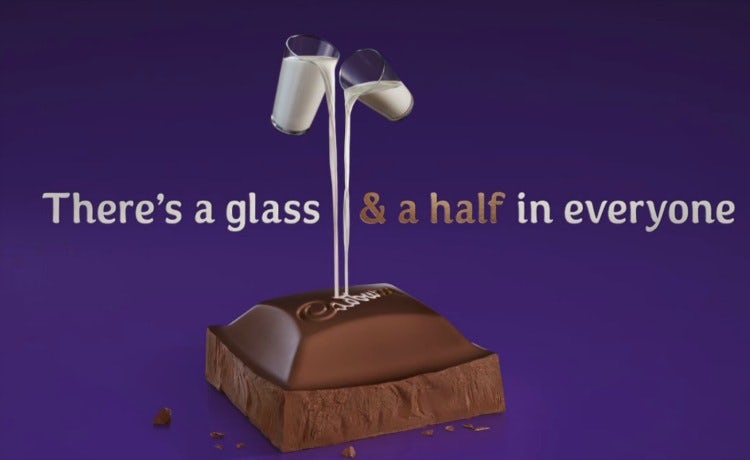Why Cadbury is taking ‘a glass and a half’ into new global markets
As Cadbury looks to accelerate growth in South East Asia and the Middle East, global brand director Ben Wicks shares its plan for establishing a loyal following overseas and why innovation must be led by marketing.
Setting strategy at a global level and then executing locally has always been the business model at Cadbury, ever since the British confectionery company sent its first recipe and ingredients on a boat to Australia in 1900.
Global brand director Ben Wicks describes the global Cadbury community as a “commonwealth of the willing”, drawing on the company’s heritage as a 194-year-old ethical business with roots across the British Commonwealth.
“One of the interesting quirks about Cadbury is if you go to Australia people think it’s Australian. You go to New Zealand and it’s the same. South Africa, the same,” says Wicks.
“People feel like they own it. Because it’s chocolate, it’s emotional. People feel like they have a personal relationship with it.”
While Cadbury has high brand awareness and is embedded into the contemporary culture of markets like the UK, Australia and New Zealand, there is still a job to be done to create the same level of saliency and affection in developing markets.
The strategy in areas of South East Asia and the Middle East is to connect with consumers in a meaningful and purpose-led way, which focuses on the taste of the chocolate. This taste element is crucial in markets where Cadbury represents an expensive option compared to the local alternatives.
To justify the price, Cadbury focuses on the quality of the ingredients and the fact that Dairy Milk, its “gold standard” product, contains a glass and a half of milk. Wicks explains that while the ‘glass and a half of milk’ symbol is highly memorable, over the past couple of years its meaning has become latent.

Cadbury has therefore decided to bring this “distinctive” visual asset firmly to the fore and put the chocolate at the centre of the story.
“In markets like Indonesia, the Philippines and some markets in the Middle East where the category and the brand are still growing, where awareness and penetration are growing, chocolate is something where you need disposable income,” Wicks explains.
“So you’ve got to establish the roots, the fundamental, intrinsic connections. It tastes great because of the abundance of milk we put in. We’re spending more time in those markets focusing on ‘glass and a half’, the very foundational credentials of the brand that we did a long time ago in the UK.”
Bringing Cadbury’s brand purpose to the fore
Cadbury sees its brand as part of the “fabric of the nation”, a big reason why its products have grown up locally and its communications have had a local flavour. Wicks also believes Cadbury’s best campaigns have always been insight-led and delivered with creativity and bravery, which makes the work memorable in popular culture.
Cadbury’s ‘Gorilla’, which was named as the best ad of the 2000s in an exclusive Marketing Week and YouGov Omnibus consumer poll, is a great example of Cadbury’s ‘Joy’ positioning, says Wicks.
However, he believes that while eating chocolate is joyful, the brand needed to move in a different direction, a decision backed up by extensive research carried out in 2016 to get under the skin of the brand.
“It said the heart of Cadbury is about belonging and connection. It’s about bringing people closer together. We also felt that while joy is entertaining, people are looking for purpose from brands. What is the meaningful thing that the brand is standing for?” he explains.
https://www.youtube.com/watch?v=5bK-GRNcP64
To define this, the team went back to the genesis of the brand in 1824, the Cadbury family and its altruistic ambition to use commerce to do good. In the middle of the industrial revolution the family constructed the Bournville estate in Birmingham, spanning a factory and housing to lift its workers out of the slums.
“It is hard to comprehend what that level of progressiveness and innovation would look like today. When you look through the history of the brand, market to market, there’s this underlying spirit of generosity. That’s a philosophy and value,” says Wicks.
The spirit of generosity is at the heart of Cadbury’s current global campaign by creative agency VCCP, which was released in January. The ‘Mum’s Birthday’ advert, featuring a little girl buying her mum a bar of Dairy Milk with a collection of her favourite trinkets, has reportedly resonated well in all Cadbury’s core markets, where the creative has been reshot to reflect the different regions.
Wicks explains that the brand is committed to “keeping it real” with this campaign, showing a story that is up-to-date with modern families. In the current climate the company believes consumers will be drawn more than ever to campaigns that focus on generosity of spirit.
In the UK, we’ve been dealing with the Cadbury acquisition by Kraft. The big American taking over the national icon; it caused a lot of acrimony. Part of it is reconnecting people with [the fact] this was a company founded by a family [in the UK].
Ben Wicks, Cadbury
“When you think about today’s world – Brexit, Trump, countries building walls – actually generosity is hugely relevant. That’s meaningful today and it’s consistent with the brand’s roots and values,” says Wicks.
READ MORE: Cadbury ditches joy positioning after six years to go ‘back to brand roots’
He also notes a move away from globalisation to local communities nurturing the people close to them. The overarching idea behind the campaign is to evoke memories of Dairy Milk as a product consumers have connected with throughout their lives.
“In the UK specifically, we’ve been dealing with the Cadbury acquisition by Kraft [which created a spin-off business called Mondelēz International, which now owns Cadbury]. The big American taking over the national icon; it caused a lot of acrimony and the press really fed that,” Wicks adds.
“It has been easy to have a go at Cadbury, so part of it is reconnecting people with [the fact] this was a company founded by a family [in the UK].”
Marketing at the heart of innovation
Another factor affecting confectionery brands in 2018 is sugar and the target set by Public Health England (PHE) to reduce the amount used in chocolate and other snacks by a fifth by 2020.
Last week, Cadbury responded to these targets by unveiling a “healthier” version of its Dairy Milk bar with 30% less sugar. The new bar will be sold alongside the original recipe when it hits shelves next year and will see the sugar replaced with fibre, rather than sweeteners. The new recipe took a team of 20 scientists, nutritionists and chocolatiers almost two years to complete.

The search for healthier alternatives started in Australia last year with the launch of a new range of chocolate bars combining the rich taste of cocoa with the creaminess of milk. Arriving in the UK next year, Cadbury will be launching Dark Milk, which is positioned as a premium – and healthier – alternative to Dairy Milk.
“The insight at the heart of that is that populations are ageing and as you age your palette matures. People start enjoying more sophisticated, challenging tastes, so at that age dark chocolate becomes more interesting. It’s a trend we see everywhere,” Wicks explains.
“It’s also perceived to be a little healthier. Often people like the idea of dark chocolate, but actually a lot of people find it too challenging to eat, too bitter.”
Wicks believes there is space in the market for the richness and sophistication of dark chocolate with the creaminess and accessibility of milk, arguing that Cadbury has always been focused on democratising chocolate.
“It’s chocolate for the masses, chocolate for the people. There’s a clear opportunity to democratise dark chocolate,” he adds.

Cadbury decided to put its weight fully behind its ‘chocolate for the masses’ ideal earlier this month by inviting chocolate fans to create their own limited edition Cadbury Dairy Milk bar. For the first time, fans can choose up to three ingredients from a range of 90,000 different combinations, before being asked to name the bar and explain the inspiration behind their creation.
Three finalists will be chosen on 31 July and have the opportunity to visit Cadbury’s Chocolate Centre of Excellence in Bournville and work with chocolate experts to create the three limited edition bars, which will go on sale in June 2019. The UK public will then be able to vote for their winning creation.
READ MORE: Why Cadbury won’t ‘throw the baby out with the bathwater’ when it comes to innovation
Wicks himself has experience of bringing brand extensions to market. In 2012, he spearheaded the launch of Dairy Milk’s Marvellous Creations in Australia, a range of Dairy Milk bars containing jelly, popping candy and rocky road bites.
At the time, chocolate was losing out to ice cream and salty snacks as a Saturday night treat. Wick’s idea was to create a chocolate bar with an element of excitement and celebration, while at the same time playing on the iconography of Roald Dahl’s ‘Charlie and the Chocolate Factory’, a book said to be inspired by Cadbury’s own factory.
It was this insight about the consumer that inspired the Marvellous Creations range, a reason why Wicks believes marketing must sit at the heart of innovation.
He says his team are in near constant consultation with the consumer, which helps them define Cadbury’s perspective on innovation, resulting in new products that are authentic to the brand.







